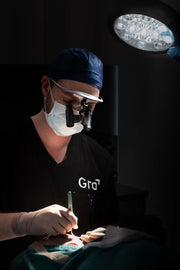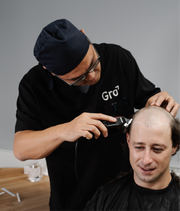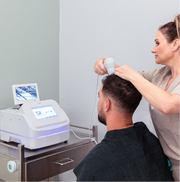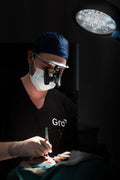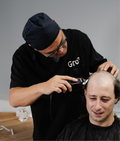At Gro Clinics, we understand that hair concerns can affect how you feel day to day. That’s why we’re introducing exosome therapy, an emerging option in regenerative medicine, now available at Gro Clinics.
This is another option in our toolkit - here to help you explore what feels right for you.
What Are Exosomes — and Why Do They Matter?
Exosomes are microscopic messengers involved in cell-to-cell communication. You can think of them as tiny carriers that deliver signals throughout the body, and are being studied for their role in hair and scalp biology.
Exosome therapy is applied at the scalp and is being studied at a cellular level in the context of hair concerns.
Is This Right for You?
Exosome therapy may be considered if you:
- Are over 40 and want to discuss non-surgical options with a practitioner
- Are experiencing androgenetic alopecia (male or female pattern hair loss)
- Have diffuse thinning across the crown or part line
- Have tried other approaches and want to explore additional options with a clinician
Typically discussed with adults over 40 or those noticing diffuse thinning - suitability varies and depends on medical history and goals.
If you’re weighing up your options, your practitioner can help you decide whether exosome therapy is suitable for you.
What to Expect from Treatment
The procedure is minimally invasive. Exosomes are applied to your scalp using microneedling, which is used to assist topical application.
- Treatment plan: Typically 4 sessions over 6–8 weeks, then review for maintenance (often every 3–6 months); schedules vary by individual assessment.
- Results timeline: Changes may be noticed over the following months; timing and outcomes vary for each person.
- Why the wait? Hair grows in cycles (including the anagen ‘growth’ phase); current research is exploring whether exosome approaches may influence hair-growth dynamics over time.
What Does the Research Say?
Exosome therapy is an evolving area of study. Early research explores potential roles in hair biology and continues to develop:
-
Some clinical studies report improvements in certain hair measures in androgenetic alopecia groups; findings vary between studies.
-
Preclinical research (lab and animal models) has examined exosome signalling and hair-cycle dynamics.
-
There are reports of reduced shedding or stabilisation in some settings; outcomes differ between individuals.
A 2023 systematic review noted potential while calling for more robust, long-term studies. We’re guided by current clinical guidance and peer-reviewed research—so your choices are informed, not driven by hype.
Exosomes vs PRP: What’s the Difference?
| Feature | Exosome Therapy | PRP (Platelet-Rich Plasma) |
|---|---|---|
| What it is | Cell-free vesicles prepared from screened donor material | Platelets prepared from your own blood |
| Source | Lab-processed product | Your blood is collected and centrifuged |
| Delivery | Typically applied topically with microneedling | Generally injected into the scalp |
| Suitability | Individual assessment required; often discussed with adults over 40 or with diffuse thinning. | Individual assessment required; often discussed across adult age groups. |
| Preparation | Product protocols may vary by manufacturer and clinic | Preparation varies by device and technique |
| Procedure steps | No blood draw | Includes a blood draw and injections |
| After-effects | Temporary redness may occur | Temporary swelling or bruising may occur |
Your Questions, Answered
Are exosomes stem cells?
No - they’re not stem cells. They’re tiny sacs that carry proteins and other signals involved in cell communication.
How many treatments will you need?
Many protocols begin with 4 sessions over 6–8 weeks, then adjust to maintenance (commonly every 3–6 months) based on response - your practitioner will tailor the plan.
Can you combine exosomes with other treatments?
Some people choose to combine therapies. Your practitioner can discuss whether this is appropriate for you.
Are there side effects?
Side effects vary. Your practitioner will explain potential risks and what to expect after treatment.
Why Choose Gro?
At Gro Clinics, we aim to make decisions feel informed and supported. Every therapy we offer is selected with care and delivered by trained clinicians.
Exosome therapy is available at Gro Clinics. Availability and suitability are determined during a consultation.
If you’re ready to explore what’s possible, book a consultation with our team today.
Disclaimer
All information is general and not a substitute for professional advice. Results vary. Any procedure carries risks. Please speak with a qualified practitioner to assess your suitability.
References
- Harsha Sreeraj, R. AnuKiruthika, K.S. Tamilselvi, D. Subha, Exosomes for skin treatment: Therapeutic and cosmetic applications, Nano TransMed, Volume 3, 2024, 100048, ISSN 2790-6760, https://doi.org/10.1016/j.ntm.2024.100048, [Accessed 1 October 2025]
- Edgar, J.R. Q&A: What are exosomes, exactly?. BMC Biol 14, 46 (2016). https://doi.org/10.1186/s12915-016-0268-z, [Accessed 1 October 2025]
- BMJ Best Practice. (n.d.). Hair loss. BMJ Publishing Group, https://bestpractice.bmj.com/topics/en-gb/223, [Accessed 7 October 2025]
- Wan, J., Kim, SB., Cartier, H. et al. A Prospective Study of Exosome Therapy for Androgenetic Alopecia. Aesth Plast Surg 49, 3151–3156 (2025). https://doi.org/10.1007/s00266-025-04817-9, [Accessed 1 October 2025]
- Cheng M, Ma C, Chen HD, Wu Y, Xu XG. The Roles of Exosomes in Regulating Hair Follicle Growth. Clin Cosmet Investig Dermatol. 2024;17:1603-1612
https://doi.org/10.2147/CCID.S465963, [Accessed 1 October 2025] - Al Ameer MA, Alnajim AT, Al Ameer A, Alsalman Z, Al Ameer GA, Alnajim ST, Alghamdi AA, Moideen R, Al Hadi EM. Exosomes and Hair Regeneration: A Systematic Review of Clinical Evidence Across Alopecia Types and Exosome Sources. Clin Cosmet Investig Dermatol. 2025 Sep 10;18:2215-2227. doi: 10.2147/CCID.S543451. PMID: 40955427; PMCID: PMC12433634, https://pmc.ncbi.nlm.nih.gov/articles/PMC12433634/, [Accessed 1 October 2025]

